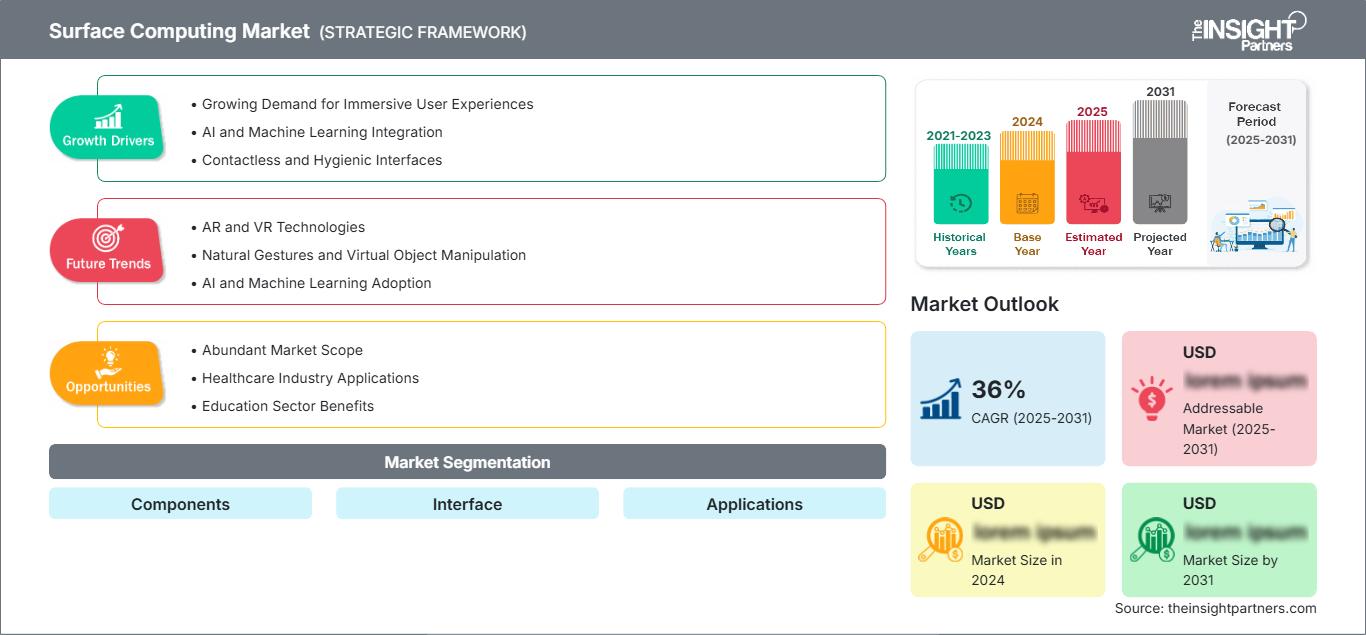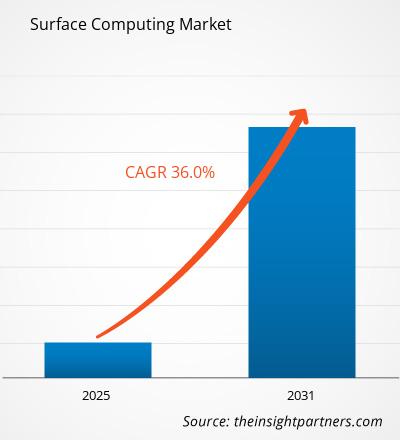Der Markt für Surface Computing wird bis 2031 voraussichtlich ein Volumen von 2012,55 Milliarden US-Dollar erreichen. Für den Zeitraum 2025–2031 wird eine durchschnittliche jährliche Wachstumsrate (CAGR) von 30,3 % erwartet.
Der Marktforschungsbericht zum Surface Computing ist nach Komponenten in verschiedene Untersegmente gegliedert. Der Bericht bietet zudem eine Analyse basierend auf Schnittstellentypen und Anwendungen, darunter Sektoren wie der akademische und der Unternehmenssektor. Die globale Analyse ist auf regionaler Ebene und für wichtige Länder aufgeschlüsselt. Die Marktbewertung für die oben genannte Segmentanalyse wird in US-Dollar dargestellt. Der Bericht „Surface Computing Market“ von The Insight Partners beschreibt die aktuelle Marktlage und das zukünftige Wachstum sowie die wichtigsten Treiber, Herausforderungen und Chancen. Dies wird verschiedenen Akteuren im Geschäftsbereich Einblicke ermöglichen, wie beispielsweise:
- Technologieanbieter/Hersteller: Um die sich entwickelnde Marktdynamik zu verstehen und potenzielle Wachstumschancen zu erkennen, können sie fundierte strategische Entscheidungen treffen.
- Investoren: Um eine umfassende Trendanalyse hinsichtlich Marktwachstumsrate, Finanzprognosen und Chancen entlang der Wertschöpfungskette durchzuführen.
- Regulierungsbehörden: Um Richtlinien zu regulieren und Aktivitäten auf dem Markt zu überwachen, mit dem Ziel, Missbrauch zu minimieren, das Vertrauen der Anleger zu wahren und die Integrität und Stabilität des Marktes zu gewährleisten.
Marktsegmentierung für Surface Computing: Komponenten
Schnittstelle
Anwendungen
Geografie
- Nordamerika
- Europa
- Asien-Pazifik
- Süd- und Mittelamerika
- Naher Osten und Afrika
Sie erhalten kostenlos Anpassungen an jedem Bericht, einschließlich Teilen dieses Berichts oder einer Analyse auf Länderebene, eines Excel-Datenpakets sowie tolle Angebote und Rabatte für Start-ups und Universitäten.
Markt für Surface-Computing: Strategische Einblicke

-
Holen Sie sich die wichtigsten Markttrends aus diesem Bericht.Dieses KOSTENLOSE Beispiel umfasst Datenanalysen, die von Markttrends bis hin zu Schätzungen und Prognosen reichen.
Wachstumstreiber des Surface-Computing-Marktes
- Steigende Nachfrage nach immersiven Nutzererlebnissen: Der zunehmende Bedarf an intuitiven und ansprechenden Interaktionsmöglichkeiten mit digitalen Inhalten treibt die Nachfrage nach Surface Computing an.
- Integration von KI und maschinellem Lernen: Fortschritte bei KI- und maschinellen Lerntechnologien verbessern Surface-Computing-Systeme und ermöglichen intelligente und personalisierte Interaktionen.
- Kontaktlose und hygienische Schnittstellen: Die hygienische Natur berührungsloser Schnittstellen, die nach der COVID-Pandemie an Bedeutung gewonnen hat, passt gut zum Wachstum des Surface Computing.
- Technologische Fortschritte und Kostensenkung: Kontinuierliche technologische Verbesserungen und sinkende Kosten beschleunigen das Wachstum des Surface-Computing-Marktes.
Zukünftige Trends des Surface-Computing-Marktes
- AR- und VR-Technologien: Augmented Reality (AR) und Virtual Reality (VR) werden Surface Computing weiterhin verbessern und immersive und interaktive Nutzererlebnisse ermöglichen. Natürliche Gesten und Manipulation virtueller Objekte: Surface Computing ermöglicht es Nutzern, virtuelle Objekte durch natürliche Gesten zu manipulieren und so die physische und die digitale Welt auf innovative Weise zu verschmelzen. Einsatz von KI und maschinellem Lernen: Die stärkere Integration von KI und maschinellem Lernen macht Surface Computing intuitiver und personalisierter, indem die Nutzerabsicht besser verstanden wird. Umweltfreundliche Lösungen: Das wachsende Bewusstsein treibt die Entwicklung energiesparender Displays und Energiegewinnungstechnologien für nachhaltigeres Surface Computing voran. Marktchancen für Surface Computing: Großes Marktpotenzial: Der Markt für Surface Computing bietet Unternehmen und Innovatoren vielfältige Möglichkeiten, und in verschiedenen Branchen entstehen neue Anwendungen. Anwendungen im Gesundheitswesen: Surface Computing kann die medizinische Ausbildung, chirurgische Eingriffe und die Patientenversorgung durch interaktive und immersive Technologien verbessern. Vorteile im Bildungssektor: Im Bildungsbereich fördert Surface Computing Kreativität und interaktive Lernerfahrungen und steigert so die Motivation der Schüler.
- Innovation im Einzelhandel: Surface Computing ermöglicht personalisierte Produktempfehlungen und verbessert die Interaktion der Kunden mit den Produktpräsentationen im Verkaufsraum.
Markt für Oberflächencomputer
Die regionalen Trends und Einflussfaktoren auf den Markt für Surface Computing im gesamten Prognosezeitraum wurden von den Analysten von The Insight Partners ausführlich erläutert. Dieser Abschnitt behandelt außerdem die Marktsegmente und die geografische Verteilung des Marktes für das Management von Herzrhythmusstörungen in Nordamerika, Europa, dem asiatisch-pazifischen Raum, dem Nahen Osten und Afrika sowie Süd- und Mittelamerika.
Umfang des Marktberichts zu Surface Computing
| Berichtsattribut | Einzelheiten |
|---|---|
| Marktgröße in 2024 | US$ XX Billion |
| Marktgröße nach 2031 | US$ 2012.55 Billion |
| Globale CAGR (2025 - 2031) | 30.3% |
| Historische Daten | 2021-2023 |
| Prognosezeitraum | 2025-2031 |
| Abgedeckte Segmente |
By KomponentenBy SchnittstelleBy AnwendungenBy Geographie
|
| Abgedeckte Regionen und Länder |
Nordamerika
|
| Marktführer und wichtige Unternehmensprofile |
|
Die Dichte der Akteure im Markt für Surface Computing: Ein Überblick über ihre Auswirkungen auf die Geschäftsdynamik
Der Markt für Surface Computing wächst rasant, angetrieben durch die steigende Nachfrage der Endnutzer. Gründe hierfür sind unter anderem sich wandelnde Verbraucherpräferenzen, technologische Fortschritte und ein wachsendes Bewusstsein für die Vorteile des Produkts. Mit steigender Nachfrage erweitern Unternehmen ihr Angebot, entwickeln innovative Lösungen, um den Kundenbedürfnissen gerecht zu werden, und nutzen neue Trends, was das Marktwachstum zusätzlich beflügelt.

- Holen Sie sich die Markt für Surface-Computing Übersicht der wichtigsten Akteure
Wichtigste Verkaufsargumente
- Umfassende Abdeckung: Der Bericht bietet eine umfassende Analyse der Produkte, Dienstleistungen, Typen und Endnutzer des Surface-Computing-Marktes und vermittelt so ein ganzheitliches Bild.
- Expertenanalyse: Der Bericht basiert auf dem fundierten Wissen von Branchenexperten und Analysten.
- Aktuelle Informationen: Der Bericht gewährleistet Geschäftsrelevanz durch die Berücksichtigung aktueller Informationen und Datentrends.
- Anpassungsmöglichkeiten: Dieser Bericht kann an spezifische Kundenanforderungen angepasst werden und sich optimal in die Geschäftsstrategien integrieren.
Der Forschungsbericht zum Surface-Computing-Markt kann somit maßgeblich dazu beitragen, das Branchenszenario und die Wachstumsaussichten zu entschlüsseln und zu verstehen. Auch wenn einige berechtigte Bedenken bestehen, überwiegen die Vorteile dieses Berichts insgesamt die Nachteile.
- Historische Analyse (2 Jahre), Basisjahr, Prognose (7 Jahre) mit CAGR
- PEST- und SWOT-Analyse
- Marktgröße Wert/Volumen – Global, Regional, Land
- Branchen- und Wettbewerbslandschaft
- Excel-Datensatz
Aktuelle Berichte
Erfahrungsberichte
Grund zum Kauf
- Fundierte Entscheidungsfindung
- Marktdynamik verstehen
- Wettbewerbsanalyse
- Kundeneinblicke
- Marktprognosen
- Risikominimierung
- Strategische Planung
- Investitionsbegründung
- Identifizierung neuer Märkte
- Verbesserung von Marketingstrategien
- Steigerung der Betriebseffizienz
- Anpassung an regulatorische Trends






















 Kostenlose Probe anfordern für - Markt für Surface-Computing
Kostenlose Probe anfordern für - Markt für Surface-Computing